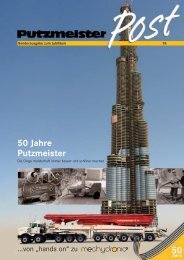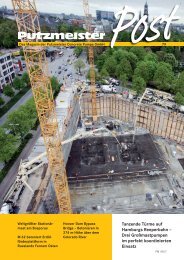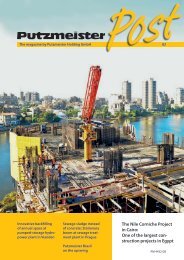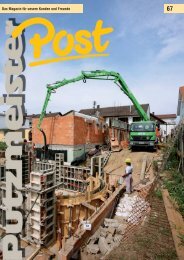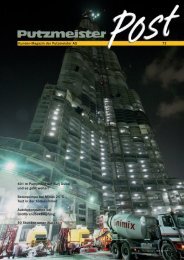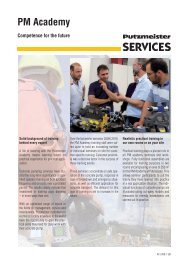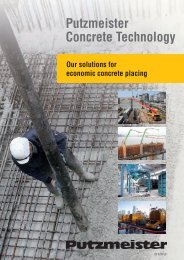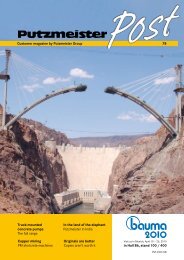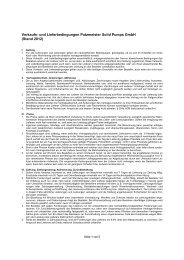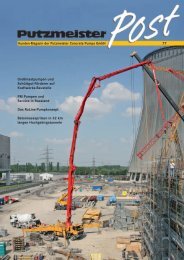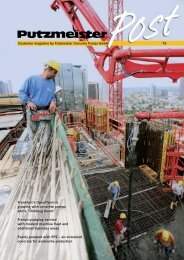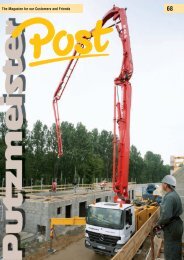The 4h pumping of Neufahrn: Large boom team places ... - Putzmeister
The 4h pumping of Neufahrn: Large boom team places ... - Putzmeister
The 4h pumping of Neufahrn: Large boom team places ... - Putzmeister
Create successful ePaper yourself
Turn your PDF publications into a flip-book with our unique Google optimized e-Paper software.
With a tunnel concreting<br />
train in the city tunnel <strong>of</strong><br />
Malmö<br />
Post<br />
<strong>The</strong> magazine by <strong>Putzmeister</strong> Concrete Pumps GmbH 80<br />
How long do truckmounted<br />
concrete<br />
pumps last?<br />
Telebelt at the thirdlargest<br />
embankment<br />
dam in the world<br />
<strong>The</strong> <strong>4h</strong> <strong>pumping</strong> <strong>of</strong><br />
<strong>Neufahrn</strong>: <strong>Large</strong> <strong>boom</strong><br />
<strong>team</strong> <strong>places</strong> concrete at<br />
motorway interchange<br />
PM 4356 GB<br />
1
Content Content / worth knowing<br />
Title story<br />
Munich: Motorway interchange at <strong>Neufahrn</strong><br />
24-hour concreting with two large <strong>boom</strong>s 4<br />
On site<br />
Five <strong>of</strong> the largest stationary <strong>boom</strong>s in the world used for the job<br />
<strong>Large</strong> construction site in central Russia relies on<br />
<strong>Putzmeister</strong> equipment 10<br />
China: Telebelt conveys concrete for dam project<br />
<strong>The</strong> third largest hydro-electric power plant in the world arises 14<br />
50 questions<br />
How long do truck-mounted concrete pumps last?<br />
No old iron here – veterans on the construction site 1<br />
Underground<br />
Sweden: on track with <strong>Putzmeister</strong> in the Malmö city tunnel<br />
Tunnel concreting train enables precise concreting<br />
<strong>of</strong> the slab track 18<br />
In brief<br />
Governor <strong>of</strong> Baghdad visits <strong>Putzmeister</strong><br />
“Perilous ride on the wild buffalo”<br />
An unusual tourist at the North Cape<br />
Worth knowing<br />
Exhibition dates / Interesting facts<br />
Photo credits<br />
Imprint<br />
4<br />
1<br />
Photo credits:<br />
Less traffic jam:<br />
A motorway interchange<br />
is being reconstructed<br />
You may well ask:<br />
How long do<br />
concrete pumps last?<br />
Unless indicated otherwise, all illustrations are copyright<br />
<strong>Putzmeister</strong> Concrete Pumps GmbH.<br />
17: Kernkraftwerk_Nowoworonesch_II, Wikimedia Commons,<br />
licensed under CreativeCommons license by-sa-<br />
3.0, Rosenergoatom · 24: China_edcp_location_map,<br />
Wikimedia Commons, licensed under CreativeCommons<br />
license by-sa-3.0, Uwe Dedering · 25: <strong>Putzmeister</strong> Machinery<br />
(Shanghai) Co., Ltd. · 34: Citytunneln_karta,<br />
Wikimedia Commons, licensed under CreativeCommons<br />
license by-sa-3.0, Rjaber · 40: Feste_Fahrbahn_FFBögl,<br />
Wikimedia Commons, licensed under CreativeCommons<br />
license by-sa-2.0, Jailbird · 45: www.demis.nl · 46: Nordkapp_2010,<br />
Wikimedia Commons, Hapes<strong>of</strong>t<br />
3 4<br />
Imprint:<br />
PM 4356 GB PM 4356 GB<br />
14<br />
More power: Telebelt<br />
<strong>places</strong> concrete for<br />
hydro-electric plant<br />
Editor:<br />
<strong>Putzmeister</strong> Concrete Pumps GmbH<br />
Max-Eyth-Str. 10<br />
72631 Aichtal · Germany<br />
Editorial department:<br />
Volker Wehner, Petra Montag<br />
<strong>Putzmeister</strong> Concrete Pumps GmbH<br />
Layout/DTP: Petra Montag<br />
<strong>Putzmeister</strong> Concrete Pumps GmbH<br />
Print:<br />
Offizin Scheufele GmbH & Co. KG<br />
Tränkestr. 17<br />
70597 Stuttgart · Germany<br />
All rights and technical amendments reserved.<br />
Although content is checked carefully, we<br />
accept no liability for sites to which links<br />
are given. <strong>The</strong> operators <strong>of</strong> external websites<br />
are solely liable for their content.<br />
Some <strong>of</strong> the illustrations show special machine<br />
variants and snapshots which do not<br />
always comply with the regulations <strong>of</strong> the<br />
Industrial Employers’ Liability Insurance<br />
Association.<br />
© by <strong>Putzmeister</strong> Concrete Pumps GmbH<br />
2010 · Printed in Germany (3.51012)<br />
2<br />
Exhibition<br />
dates<br />
January – April 011<br />
18. – 21.01.2011<br />
WOC World Of Concrete,<br />
Las Vegas/USA<br />
08. – 11.02.2011<br />
bC India, Mumbai/India<br />
22. – 26.03.2011<br />
ConExpo, Las Vegas/USA<br />
06. – 08.04.2011<br />
USETEC, Cologne/Germany<br />
By the way…<br />
In 2009, a total <strong>of</strong> 1,338 customers<br />
took part in 74 <strong>Putzmeister</strong> Academy<br />
seminars, with numbers growing<br />
all the time.<br />
Over a lengthy period, concrete<br />
pump owners have observed the<br />
effects <strong>of</strong> their machine operators<br />
undertaking training sessions with<br />
resulting qualifications on their accident<br />
frequency and costs. <strong>The</strong> results<br />
show clearly that investment<br />
in training pays <strong>of</strong>f.<br />
worth<br />
know<br />
ing<br />
5
Title story Title story<br />
4-hour <strong>pumping</strong> at <strong>Neufahrn</strong>:<br />
<strong>The</strong> large-<strong>boom</strong> <strong>team</strong> concretes<br />
at the motorway junction<br />
Position M 6 -6<br />
City<br />
Munich<br />
Position M 58-5<br />
✈<br />
Munich<br />
6<br />
On the morning <strong>of</strong> 4th August, two large<strong>boom</strong><br />
concrete pumps arrived at the <strong>Neufahrn</strong><br />
motorway junction north <strong>of</strong> Munich<br />
– one M 58-5 from Berger Beton and one<br />
M 6 -6 from BFM Betonförderdienst in<br />
Munich.<br />
A sunny, almost autumnal day announces<br />
itself with hazy, mild air and single wisps<br />
<strong>of</strong> low cloud. <strong>The</strong> weather will stay beautiful<br />
– perfect for the planned 4-hour<br />
concreting that is due to take place today.<br />
One notices the men on the construction<br />
site are in a good mood – the best prerequisite<br />
for starting the work and for the<br />
challenging task that lies ahead <strong>of</strong> them.<br />
Narrow junction at <strong>Neufahrn</strong><br />
This structure, which, when viewed from<br />
above, looks like a fl atly pressed four-leaf<br />
clover, can no longer cope with today‘s traffi c<br />
volumes. Two national motorways intersect<br />
at the <strong>Neufahrn</strong> junction – the A 9 and the<br />
A 92. Along with the Munich motorway<br />
ringroad (A 99) and the A 8 Ulm-Munich-<br />
Salzburg, the A 9 is the most important north-south<br />
route, especially for domestic and<br />
international commercial and holiday traffi c.<br />
<strong>The</strong> A 92 connects the state capital <strong>of</strong> Munich<br />
with its airport and is also important<br />
for Eastern European traffi c.<br />
View <strong>of</strong> the construction site from the southern ramp.<br />
<strong>The</strong> column for the nd bridge section has already been formed.<br />
p <strong>The</strong> M 6 -6 on the north-western<br />
ramp at the motorway junction<br />
4 5<br />
7<br />
8
Title story Title story<br />
<strong>The</strong> average volume <strong>of</strong> traffi c from the airport<br />
towards Munich is currently approximately<br />
24,000 vehicles in 24 hours. An<br />
average daily traffi c fl ow <strong>of</strong> approximately<br />
38,000 vehicles in 24 hours is predicted for<br />
the year 2020. On average, that would be approximately<br />
1,600 vehicles travelling via the<br />
<strong>Neufahrn</strong> junction per hour – not to mention<br />
rush-hour traffi c.<br />
<strong>Large</strong>-scale reconstruction is required<br />
In view <strong>of</strong> this projection, the only option is<br />
a speedy connection via the existing motorway<br />
junction using a direct ramp. <strong>The</strong> current<br />
single-lane exit via a quadrant <strong>of</strong> the<br />
„clover“ will be completely replaced by a so-<br />
called „fl yover“ that channels a two-lane carriageway<br />
from the A 92 to the A 9 towards<br />
the south.<br />
<strong>The</strong> customer is Autobahndirektion Südbayern<br />
and the contractor is Hentschke Bau<br />
GmbH in Bautzen.<br />
<strong>The</strong> construction work at the <strong>Neufahrn</strong> motorway<br />
junction commenced in April 2009<br />
with the reconstruction <strong>of</strong> a connecting<br />
ramp and the spillage that is required to<br />
build the new bridge, with 110,000 cubic<br />
metres <strong>of</strong> delivered soil. In 2010, comprehensive<br />
excavation and ceiling work took<br />
place at the <strong>Neufahrn</strong> motorway junction,<br />
as well as bridge construction work in the<br />
whole area. <strong>The</strong> construction project should<br />
be complete by the end <strong>of</strong> 2011.<br />
q In a good mood and with everything under control:<br />
Harry Kirchmaier drives the M 6 -6 from BFM and Stefan Vogel drives the M 58-5<br />
from Berger<br />
10<br />
p Dipl.-Ing. (engineering masters) Felix<br />
Raschke, site manager for Hentschke<br />
Bau GmbH, the company commissioned<br />
for the project<br />
9<br />
Flyover concreted in two sections<br />
Back to the concreting at the „fl yover“: Dipl.-<br />
Ing. (masters in engineering) Felix Raschke,<br />
the site manager, explains: „Today, we are<br />
concreting section 1 <strong>of</strong> the ‚Flyover‘“.That is<br />
the longer stretch, at 120 m. We started work<br />
on the carcass in February <strong>of</strong> this year and<br />
the construction work will continue until October.<br />
After that comes the 2nd section – the<br />
road section that is 80 m long.“In answering<br />
the question about the particularities <strong>of</strong> this<br />
motorway construction site, he responded<br />
saying that the scaffolding work could only<br />
be carried out at night. It was extremely important<br />
that the motorway was completely<br />
closed for this work and the strict compliance<br />
with closing times applied here.<br />
Concreting commenced at 6 a.m. Each <strong>of</strong><br />
the two truck-mounted concrete pumps<br />
stands fully-supported at the foot <strong>of</strong> one <strong>of</strong><br />
the construction columns within one <strong>of</strong> the<br />
northern clover quadrants <strong>of</strong> the motorway<br />
junction. From this location, they pump concrete<br />
to the sites <strong>of</strong> concrete placement on<br />
the approx. 12 m high bridge. Meanwhile,<br />
the traffi c fl ows freely on the circular paths<br />
<strong>of</strong> the exits and under the structure.<br />
At the beginning, the end hoses <strong>of</strong> both <strong>boom</strong>s<br />
and the respective machine operator <strong>of</strong> each<br />
concrete pump met in the middle <strong>of</strong> the bridge<br />
construction site. From there, each <strong>of</strong> them<br />
works outwards.<strong>The</strong> horizontal reach <strong>of</strong> the<br />
q <strong>The</strong> <strong>pumping</strong> duo started the concreting in the centre <strong>of</strong> the 1 0 m bridge.<br />
From there, the <strong>boom</strong>s move away from each other as they work.<br />
large <strong>boom</strong> is fully utilised. <strong>The</strong> high level <strong>of</strong><br />
fl exibility <strong>of</strong> the 6-arm or 5-arm <strong>boom</strong> was an<br />
important criteria for the managing directors<br />
<strong>of</strong> BFM and Berger when they were making<br />
the decision for a new large <strong>boom</strong>. When used<br />
together with the sensitive Ergonic ® control,<br />
the strengths <strong>of</strong> two <strong>boom</strong>s can be fully utilised<br />
in a situation such as this.<br />
<strong>The</strong> M 62-6 from BFM and the M 58-5 from<br />
Berger Beton have the longest horizontal<br />
reach <strong>of</strong> any pumps across Bavaria. With<br />
each having fl eets <strong>of</strong> more than forty concrete<br />
pumps, both <strong>of</strong> these companies are among<br />
the largest service providers in the state <strong>of</strong><br />
Bavaria.<br />
6 PM 4356 GB PM 4356 GB 7<br />
11
Title story Title story<br />
In 24 hours, a total <strong>of</strong> approx. 2,000 m 3 <strong>of</strong><br />
concrete C40/50 was placed with a compressive<br />
strength <strong>of</strong> 42.5 N/mm 2 (exposition<br />
classes XC4, XD1, XF2). This is the quantity<br />
<strong>of</strong> concrete for the entire cross-section <strong>of</strong> the<br />
structure <strong>of</strong> section 1 including footbridges<br />
and carriageway slabs (see the box containing<br />
data about the concreting). <strong>The</strong> complete<br />
superstructure (sections 1 and 2) will<br />
contain 3,400 m 3 <strong>of</strong> concrete.<br />
So that traffi c can ultimately travel on the<br />
road comfortably and safely, the fi nished<br />
concrete surface receives another 8 cm thick<br />
layer to the overall construction. <strong>The</strong> concrete<br />
is fi rst primed and completely sealed<br />
using epoxy resin. An asphalt sheeting (0.5<br />
cm) comes next and then a protective layer<br />
<strong>of</strong> mastic asphalt (3.5 cm thick). Finally, the<br />
surface <strong>of</strong> the road is formed by a 4.0 cm<br />
surface layer <strong>of</strong> stone mastic asphalt. n<br />
Technical data <strong>of</strong> the concrete pumps on site<br />
M 58-5 M 6 -6<br />
Folding type 5-Arm roll-Z-fold 6-Arm roll-Z-fold<br />
Vertical reach 57.6 m 61.1 m<br />
Horizontal reach 53.6 m gross 57.1 m gross<br />
49.4 m net 52.4 m net<br />
Reach depth 42.4 m 44.3 m<br />
Unfolding height 12.3 m 23 m<br />
Delivery line DN 125, max. 85 bar Arm 1, 2 DN 125, max. 85 bar<br />
Arm 3, 4, 5, 6 DN 117, max. 85 bar<br />
Support width front / rear front / rear<br />
normal approx. 11.1 m / approx. 11.5 m approx. 12.1 m / approx. 12.3 m<br />
OSS approx. 8.7 m / approx. 8.0 m approx. 8.8 m / approx. 8.3 m<br />
Properties <strong>of</strong> fresh concrete<br />
Strength class C40/50<br />
q In the middle <strong>of</strong> the motorway but nevertheless secure: <strong>The</strong> concreting is carried<br />
out quietly while the traffi c can fl ow freely under the bridge construction.<br />
This photo shows the M 58-5 on the north-eastern ramp.<br />
12 13<br />
Exposition classes XC4 Changing wet and dry (e.g. exterior components with direct<br />
exposure to rainfall, components in water tidal zones)<br />
XD1 Moderate moisture (e.g. components in areas where water<br />
may spray from traffi c areas)<br />
XF2 Moderate water saturation with de-icing agents (e.g. concrete<br />
components in areas where water may spray from traffi c<br />
areas that have been treated with de-icing agents)<br />
t To determine the water content, the<br />
concrete is heated up until it no longer<br />
contains any liquid.<strong>The</strong> difference in<br />
weight can be used to determine the<br />
water content.<br />
8 PM 4356 GB PM 4356 GB 9<br />
Steel used<br />
Untensioned reinforced steel 280 t Prestressing steel 107 t<br />
Thickness <strong>of</strong> the layer <strong>of</strong> placed concrete<br />
in the area <strong>of</strong> the webs 2.40 m in the centre <strong>of</strong> the carriageway 0.35 cm<br />
q After a quick clean, the truck mixers<br />
rejoin the queue <strong>of</strong> motorway traffi c in<br />
order to fetch more concrete<br />
14<br />
‚ Exposition classes<br />
and what they mean<br />
To ensure that the durability is suffi cient,<br />
concrete components must be strong<br />
enough to withstand chemical and physical<br />
impact on their environment and<br />
their use. <strong>The</strong> impacts from the various<br />
environmental conditions are classifi ed<br />
into exposition classes that may have an<br />
impact on the concrete, the reinforcing<br />
steel and metallic components and that<br />
are not accounted for as loads during<br />
the constructive assessment. From this,<br />
the requirements are derived for the<br />
composition <strong>of</strong> the concrete to be used,<br />
as well as the concrete cover and the<br />
permitted crack width.<br />
<strong>The</strong> designations for the individual exposition<br />
classes are made up <strong>of</strong> the letter<br />
X (for exposition), the identifi cation<br />
for the type <strong>of</strong> damaging effect and a<br />
number that denotes the intensity <strong>of</strong> the<br />
damaging effects. <strong>The</strong> following abbreviations<br />
are used from English for the<br />
various types <strong>of</strong> effects:<br />
0 for zero risk (no risk <strong>of</strong> attack)<br />
C for carbonation<br />
D for de-icing salt (chlorides that are<br />
capable <strong>of</strong> changing, e.g. from deicing<br />
salt)<br />
S for seawater<br />
F for frost (frost and de-icing salt)<br />
A for chemical attack<br />
M for mechanical abrasion, wear, or<br />
similar<br />
<strong>The</strong> strength <strong>of</strong> the relevant ambient<br />
condition is assigned a classifi cation<br />
from 1 to 4.<br />
In Germany, the exposition classes are<br />
regulated by DIN 1045-1 (08-2008).<br />
In contrast to the previous version from<br />
2001, the effect W „concrete corrosion<br />
due to alkali silicic acid“ has been added<br />
to the exposition classes. No minimum<br />
concrete strength class is assigned to<br />
this exposition.<br />
[Source: wikipedia.de, licensed under<br />
http://creativecommons.org/licenses/by-sa/3.0/deed.de.]
On site On site<br />
Five MXKD 50 at a major nuclear power<br />
plant construction site in central Russia<br />
Five <strong>of</strong> the largest stationary <strong>boom</strong>s in the<br />
world – <strong>Putzmeister</strong> MXKD 50 – are taking<br />
part in the construction <strong>of</strong> the Novovoronezh<br />
NPP-2 nuclear power plant on the banks <strong>of</strong><br />
the Don river. At the end <strong>of</strong> 2009, <strong>Putzmeister</strong><br />
was awarded a contract to provide the equipment<br />
for concrete distribution at the reactor<br />
block: Five placing <strong>boom</strong>s with a horizontal<br />
reach <strong>of</strong> 50 m (fi tted on Manitowoc/Potain lattice<br />
towers up 50 m tall), two BSA 2110 HP-D<br />
stationary concrete pumps and a 300 m<br />
ZX 125 delivery line.<br />
At the start <strong>of</strong> 2010 and on a total <strong>of</strong> 10<br />
tautliners (trucks that have a sliding curtain<br />
for crane loading), the disassembled <strong>boom</strong>s<br />
travelled from the factory in Gründau to<br />
<strong>Putzmeister</strong>‘s Russian headquarters in Moscow.<br />
From there, the <strong>boom</strong>s travelled on to<br />
the site <strong>of</strong> use, approx. 500 km further south<br />
in Novovoronezh. n<br />
Technical data MXKD 50<br />
Number <strong>of</strong> arms 4<br />
Folding type Roll fold<br />
Horizontal reach 49.9 m gross<br />
Reach depth 39.2 m<br />
Vertical reach 46.5 m<br />
Weight 37,550 kg<br />
p Disassembled and loaded: A total <strong>of</strong> ten trucks rolled on to Russia<br />
15<br />
p Autumn 010: Technicians from <strong>Putzmeister</strong> RUS travelled from Moscow and<br />
are currently installing the concreting equipment at the huge construction site.<br />
Novovoronezh-II-1<br />
q With a horizontal reach <strong>of</strong> almost 50 m, the MXKD 50 is the largest stationary <strong>boom</strong> in the world on site<br />
16 17<br />
Reactor type WWER-1200 (AES 2006)<br />
Power 1,085 MW (net)<br />
1,170 MW (gross)<br />
Start <strong>of</strong> construction 20.06.2007<br />
Commissioning planned for 31.12.2012<br />
Operator Rosenergoatom<br />
10 11<br />
18
50 questions 50 questions<br />
6<br />
Technology · Question 6<br />
How long do truck-mounted<br />
concrete pumps last?<br />
19<br />
21<br />
Even <strong>Putzmeister</strong> engineers continue to<br />
be surprised by how long truck-mounted<br />
concrete pumps can be in service: some<br />
machines have almost 40 years <strong>of</strong> service<br />
under their belt.<br />
Luckily, <strong>Putzmeister</strong>‘s Services department<br />
employs true experts when it comes to spare<br />
parts for old truck-mounted concrete pumps:<br />
“Our computerised spare parts management<br />
only began in 1983. Before then, everything<br />
was done in our heads or was found in old<br />
documents.”<br />
Several times a month, we receive requests<br />
that can only be solved by human intelligence.<br />
One such example is the water-hydraulic<br />
driven concrete pump B232, manufactured<br />
in 1971. To put this machine out <strong>of</strong><br />
service has never crossed the mind <strong>of</strong> the<br />
Polish entrepreneur Grzegorz Kujawski. He<br />
regularly orders new spare parts.<br />
What makes truck-mounted concrete<br />
pumps grow old<br />
Three factors determine the service life <strong>of</strong> a<br />
truck-mounted concrete pump:<br />
• how the machine is serviced and<br />
maintained,<br />
• the number <strong>of</strong> hours that it is in<br />
operation,<br />
• and the quantity <strong>of</strong> concrete that is<br />
pumped.<br />
p B / 9 years old/Poland<br />
This water-hydraulic driven concrete pump B has been in use since 1971. Even in<br />
008, it was still <strong>pumping</strong> a daily volume <strong>of</strong> 150 cubic metres <strong>of</strong> concrete.<br />
According to the requirements that<br />
<strong>Putzmeister</strong>‘s engineers are given, the<br />
truck-mounted concrete pumps should be<br />
able to keep working for at least 10 years.<br />
<strong>The</strong> critical factor here is the design <strong>of</strong> the<br />
placing <strong>boom</strong>. During <strong>pumping</strong> operations,<br />
the <strong>boom</strong> is particularly stressed by the<br />
load shifting. <strong>The</strong> number <strong>of</strong> load changes<br />
is determined by the pump output and the<br />
operating hours.<br />
Anti-aging – past and present<br />
In the past, designers could rely upon their<br />
knowledge and experience and consult with<br />
others regarding standards and regulations.<br />
If there was any doubt, they increased the<br />
strength <strong>of</strong> the material at heavily-used<br />
points on the placing <strong>boom</strong>. As early as the<br />
end <strong>of</strong> the 1970s, <strong>Putzmeister</strong> owned a test<br />
q M 45-5/ years old/Austria<br />
This M 45-5 worked almost 1 ,000 operating hours over 0 years before getting a<br />
new owner.<br />
20<br />
p M 1- / 7 years old/Cyprus<br />
This M 1- “Triplet” that was manufactured in 198 is still in top form. For its 6th birthday in 00 , it underwent a major overhaul<br />
and was affectionately given the name “Our favourite grandmother”, which was prominently displayed on the <strong>boom</strong>.<br />
rig to simulate long periods <strong>of</strong> use. If the<br />
<strong>boom</strong> passed the test, the design could go<br />
into series production. In practice, something<br />
became clear: <strong>The</strong> machines keep working<br />
for considerably longer than 10 years – provided<br />
that they are well maintained. As is<br />
the case with the machine from Poland.<br />
Since the beginning <strong>of</strong> the 1990s, the designers<br />
have used finite element analysis<br />
(FEM) to precisely calculate the stress on<br />
the components. A screen in the s<strong>of</strong>tware<br />
programme shows the tension that will later<br />
appear in the material and shows the critical<br />
points. <strong>The</strong> design, material and material<br />
thickness can then be optimised. Using a<br />
new <strong>boom</strong> test rig, the engineers can simulate<br />
years <strong>of</strong> the life-cycle <strong>of</strong> the <strong>boom</strong> at<br />
high speed.<br />
q M 46-5/7 years old/China<br />
Since 00 , this M 46-5 has pumped an annual volume <strong>of</strong> 90,000 m in Shanghai!<br />
That is three times more than the same machines in Europe.<br />
Practical test in China<br />
How well do the computer-optimised designs<br />
actually work in practice? <strong>The</strong>re are no machines<br />
that are 40 years old yet. However,<br />
there are truck-mounted concrete pumps<br />
that have worked considerably more than<br />
you would assume from their year <strong>of</strong> manufacture.<br />
In China, young machines are already old.<br />
<strong>The</strong> M 46 shown (year <strong>of</strong> manufacture:<br />
2003) has worked non-stop since its delivery:<br />
<strong>pumping</strong> volumes <strong>of</strong> 90,000 cubic metres<br />
<strong>of</strong> concrete each year are the norm – at peak<br />
times, the <strong>pumping</strong> volume increases to<br />
up to 12,000 cubic metres <strong>of</strong> concrete each<br />
month. By comparison: In Europe, large<br />
<strong>boom</strong> truck-mounted concrete pumps deliver<br />
approx. 30,000 cubic metres <strong>of</strong> concrete<br />
each year. In terms <strong>of</strong> European machines,<br />
this machine has already survived the required<br />
10 years well – and it continues to<br />
run and run and run. n<br />
1 PM 4356 GB PM 4356 GB 1<br />
22
On site<br />
Telebelt conveys enormous masses<br />
<strong>of</strong> concrete at the third-largest<br />
embankment dam in the world<br />
At the Jinsha River – a tributary <strong>of</strong> the<br />
Yangtze – the Xiluodu hydro-electric<br />
plant is currently being built. Its main<br />
purpose is to generate electricity but it<br />
also fulfi ls other tasks: fl ood protection,<br />
deposition <strong>of</strong> sediment, improvement <strong>of</strong><br />
shipping conditions, etc. It is expected<br />
to produce from 57 to 64 billion kilowatt<br />
hours <strong>of</strong> electrical energy each year,<br />
making this plant the third largest hydroelectric<br />
plant in the world.<br />
A double-curved arch dam should dam up a<br />
storage lake <strong>of</strong> 12.67 billion m 3 . <strong>The</strong> absolute<br />
elevation <strong>of</strong> the dam crest is 610 m, the maximum<br />
height <strong>of</strong> the dam is 278 m and the<br />
overall length is 700 m. <strong>The</strong> total excavated<br />
material for this project amounts to 39.81<br />
million m 3 <strong>of</strong> which 25.61 million m 3 is above-ground<br />
excavation and 14.20 million m 3 is<br />
from the construction <strong>of</strong> tunnels.<br />
In total, 16.72 million m 3 <strong>of</strong> concrete is required<br />
for this project and 6.60 million m 3 <strong>of</strong><br />
this is required just for the body <strong>of</strong> the wall.<br />
<strong>The</strong> concreting work commenced in 2008. It<br />
is expected that the fi rst generator sets can be<br />
installed in June 2012. From June 2013, the<br />
fi rst electrical energy should be generated<br />
and the entire project should be completed<br />
by 2015. US$ 7.36 billion has been invested<br />
in the Xiluodu hydro-electric plant.<br />
<strong>The</strong> devices in the Xiluodu dam that are<br />
planned for fl ood water fl ow include seven<br />
overfl ow drainage openings at a size <strong>of</strong> 12.5 m<br />
x 13.5 m, below them eight outlets at a size<br />
<strong>of</strong> 6 m x 6.7 m and four exceptionally large<br />
overfl ow tunnels (with a diameter <strong>of</strong> up to<br />
15 m) – two tunnels on the right embankment<br />
and two more on the left. <strong>The</strong> overfl ow<br />
capacity <strong>of</strong> the project amounts to up to<br />
49,923 m 3 /s. <strong>The</strong> power that is generated by<br />
the overfl ows is almost 100 million kilowatts<br />
and is therefore the highest in the world. <strong>The</strong><br />
four overfl ow tunnels are the largest <strong>of</strong> their<br />
kind in the world and have a discharge rate<br />
<strong>of</strong> 16,000 m 3 /s, which is about a third <strong>of</strong> the<br />
entire outlet capacity <strong>of</strong> the plant.<br />
<strong>The</strong> water quantity and fl ow rate place<br />
high demands on the concrete<br />
<strong>The</strong>se numbers are not just attributed to the<br />
size <strong>of</strong> the tunnel but also to the fl ow rate<br />
<strong>of</strong> the river, which is amongst the fastest in<br />
the world (up to 50 m/s). Since these four<br />
overfl ow tunnels were designed to cope with<br />
exceptionally large quantities <strong>of</strong> water at an<br />
extremely high fl ow rate, the concrete that is<br />
used here must be <strong>of</strong> outstanding quality. <strong>The</strong><br />
difference between this concrete and a pumpable<br />
concrete mix lies mainly in the proportions<br />
<strong>of</strong> the individual concrete raw materials<br />
23<br />
‚ <strong>The</strong> longest river in Asia<br />
with the changing name<br />
<strong>The</strong> 6,300 km long Chang Jiang (also<br />
known as the Yangtze - the “Long River”) is<br />
the longest river in Asia and, after the Nile<br />
and the Amazon, is the third-longest river<br />
in the world. It originates as the Dri Chu<br />
(Tibetan “river <strong>of</strong> the female yak”) from the<br />
Ganjajubu glacier at an altitude <strong>of</strong> 5,405 m<br />
and continues under the name <strong>of</strong> Jinsha<br />
Jiang – “Gold Sands River” – from north<br />
to south along the entire border between<br />
Sichuan and Tibet. In the Hengduan Mountains,<br />
it crosses the border between Sichuan<br />
and Yunnan. From the city <strong>of</strong> Shuifu, it<br />
fl ows under the name <strong>of</strong> Yangtze until it<br />
reaches the East China Sea to the north <strong>of</strong><br />
Shanghai.<br />
‚ <strong>The</strong> dam should reduce<br />
sludge load<br />
In the Red Basin, the Yangtze is fed by numerous<br />
tributaries that drain, for example,<br />
the eastern slopes <strong>of</strong> the Tibetan highlands.<br />
T I B E T A N P L A T E A U<br />
14 PM 4356 GB PM 4356 GB 15<br />
TIBET<br />
that are used. Pumpable concrete requires a<br />
relatively high fl owability so that it can fl ow<br />
through the delivery line. This means that<br />
concrete raw materials such as cement and<br />
fl y ash are required in large quantities. However,<br />
cement creates a lot <strong>of</strong> hydration heat<br />
when setting the concrete, meaning that the<br />
temperature and crack formation are diffi cult<br />
to control. <strong>The</strong> dissipation <strong>of</strong> the hydration<br />
heat may pose a problem, particularly with<br />
structures such as a dam.<br />
25<br />
Mekong<br />
<strong>The</strong> tributaries feed the Yangtze with large<br />
quantities <strong>of</strong> sand, silt and clay – an annual<br />
quantity <strong>of</strong> approximately 680 million tons,<br />
which is as much as the Nile, the Mississippi<br />
and the Amazon together! This makes the<br />
“Long River” one <strong>of</strong> the most sediment-rich<br />
rivers in the world. Where it is damed – like<br />
at the huge Three Gorges Dam – the fl ow<br />
velocity <strong>of</strong> the water slowes down, sediment<br />
is stored in the reservoir and gradually silts<br />
up. <strong>The</strong> Xiluodu dam should counteract this.<br />
It is expected that the dam should reduce<br />
the quantity <strong>of</strong> sludge in the Yangtze by a<br />
third.<br />
‚ Mammoth producers<br />
<strong>of</strong> energy<br />
Once completed, the Xiluodu hydro-electric<br />
plant will produce 12,600 MW <strong>of</strong> power.<br />
This means that, with regard to power<br />
plant capacity, it would be the secondlargest<br />
hydro-electric plant in China after<br />
the Three Gorges project and the third-largest<br />
in the world. <strong>The</strong> China Yangtze Three<br />
Gorges Project Development Corp. is plan-<br />
Jinsha Jiang<br />
YUNNAN<br />
SICHUAN<br />
Xiluodu<br />
Dam<br />
Telebelt comes out ahead<br />
Telebelt is a mobile belt conveyor that can<br />
continuously convey any kind <strong>of</strong> bulk materials<br />
and concrete and is unrestricted by the<br />
pumpability <strong>of</strong> the concrete. Telebelt is therefore<br />
the perfect solution for pouring highquality<br />
mass concrete as it not only means<br />
that fewer cracks are formed but it also reduces<br />
the costs for the concrete.<br />
Yangtze<br />
On site<br />
ning three more giant hydro-electric plants<br />
at the overfl ow <strong>of</strong> the Yangtze, namely Wudongde,<br />
Baihetan and Xiangjiaba. At 38.5<br />
million kWh each year, their combined<br />
power generation should be double that <strong>of</strong><br />
the Three Gorges Project.<br />
‚ Special confi guration:<br />
Arch dam<br />
In valleys that are very high and narrow,<br />
the preferred dam to build is the arch dam.<br />
<strong>The</strong> wall forms a vertically and horizontally<br />
tensioned arch towards the side <strong>of</strong> the<br />
water. Due to the arch-shaped design that<br />
is directed against the fl ow <strong>of</strong> the river, the<br />
mass <strong>of</strong> water is distributed over a larger<br />
surface area and therefore puts less stress<br />
on each unit <strong>of</strong> area. Signifi cantly fewer<br />
materials are required to construct these<br />
dams than are required for other types <strong>of</strong><br />
dams. However, the water pressure is diverted<br />
over the arch to the foundations in<br />
the mountain at the side. <strong>The</strong> attachment<br />
to the rock is therefore particularly important<br />
with this wall design.<br />
Three Gorges<br />
Dam<br />
C h i n a<br />
<strong>The</strong> fi rst Telebelt TB 105 delivered by<br />
<strong>Putzmeister</strong> has been used in the Three<br />
Gorges Dam project since the year 2000. To<br />
date, the number <strong>of</strong> operating hours amounts<br />
to more than 20,000 hours and the device<br />
continues to work properly – clear pro<strong>of</strong> <strong>of</strong><br />
the robustness and reliability <strong>of</strong> the Telebelt.<br />
Due to this experience, the company responsible<br />
for the Three Gorges project ordered<br />
two more Telebelts <strong>of</strong> the new type TB 110G<br />
for the <strong>team</strong> from SinoHydro Bureau 7. Since<br />
24
On site<br />
p Telebelt being used to concrete the cable crane platform<br />
q Telebelt is placing concrete at the gate <strong>of</strong> a tunnel<br />
16<br />
26<br />
the machines are very convenient to operate<br />
and the <strong>boom</strong> can be gently and smoothly<br />
telescoped, swung, lifted and lowered, the<br />
two TB 110G devices are very popular on the<br />
construction site. <strong>The</strong> machine has evoked<br />
a positive response among the workers from<br />
SinoHydro Bureau 7: Concrete pouring has<br />
become child‘s play. However, if we look at<br />
the quantity <strong>of</strong> concrete that the Telebelt<br />
must continuously pour for each concreting –<br />
more than 1,000 m 3 <strong>of</strong> concrete – it becomes<br />
clear just how hard the work is for the workers<br />
on the construction site.<br />
Telebelt is in great demand across the<br />
entire power plant construction site<br />
<strong>The</strong> Xiluodu hydro-electric plant is a huge<br />
construction site. Several projects are ongoing<br />
at the same time and these are co-ordinated<br />
centrally. <strong>The</strong> individual construction<br />
<strong>team</strong>s work closely together.<br />
It is <strong>of</strong>ten the case that immediately after one<br />
concreting task has fi nished, the belt conveyor<br />
travels to the next site <strong>of</strong> use on the<br />
construction site. Thanks to its high levels <strong>of</strong><br />
fl exibility and mobility, the Telebelt is <strong>of</strong>ten<br />
27<br />
used “on the front line”. <strong>The</strong> TB 110G from<br />
<strong>Putzmeister</strong> was therefore not only used on<br />
the construction sites <strong>of</strong> SinoHydro Bureau 7<br />
(in other words, to construct the overfl ow<br />
tunnels, the foundations <strong>of</strong> the cable crane<br />
structure and for above-ground concreting,<br />
etc.), but it also considerably helped the<br />
construction sites <strong>of</strong> Hydro Bureau 6 and Hydro<br />
Bureau14 (among others) when constructing<br />
the surge tank, the underwater outlet,<br />
the main transformer building etc. As a result,<br />
on one occasion, the Telebelt was used<br />
on fi ve different construction sites within<br />
six days, during which time it continuously<br />
placed 4,800 m 3 <strong>of</strong> concrete for the overfl ow<br />
tunnel, the cable crane platform and the underwater<br />
outlet. <strong>The</strong> high level <strong>of</strong> effi ciency<br />
demonstrated by the belt conveyor is another<br />
performance feature that is recognised on<br />
the construction site. For example, the TB<br />
110G generally requires only 2.5 minutes<br />
to drain a mixer <strong>of</strong> 6 m 3 for the work on the<br />
cable crane platform and, at a slightly higher<br />
speed, it requires only 1.8 minutes to drain<br />
the mixer. This extremely high machine output<br />
signifi cantly contributes to completing<br />
the work within the scheduled time. ■<br />
Greater versatility with Telebelt in<br />
semi-trailer confi guration<br />
• Chassis versatility meets local weight<br />
restrictions<br />
p Telebelt pumps concrete for the<br />
overfl ow tunnel<br />
u <strong>The</strong> aggregate in the concrete that is<br />
used is up to 60 mm. A pump doesn‘t<br />
stand a chance, but it‘s a “feast” for the<br />
Telebelt.<br />
• Greater mobility on-site<br />
• Material placement does not rely on the<br />
chassis engine<br />
• Promotes lower operation costs and<br />
reduced fuel consumption<br />
On site<br />
• Tandem Dolly available to move<br />
Telebelt semi-trailer on-site with a<br />
dozer, wheel loader or other available<br />
equipment<br />
PM 4356 GB 17<br />
31<br />
28<br />
29<br />
30
Underground<br />
With the “Special train” to Sweden:<br />
A slab track system is being<br />
created in the Malmö city tunnel<br />
A slab track is being laid in the tunnel<br />
section with two individual 6 km tunnels.<br />
<strong>The</strong> sleepers are embedded in concrete<br />
and can absorb the vibration caused by<br />
high-speed trains in a better way due to<br />
having an extremely fl exible insert.<br />
Maximum precision is required when the<br />
tracks are installed. <strong>The</strong> sleeper shoes<br />
that have been freshly embedded in the<br />
concrete must not be subjected to vibration.<br />
Even the slightest variations in the<br />
alignment <strong>of</strong> the tracks can result in the<br />
railway no longer complying with the original<br />
designs for high-speed travel.<br />
<strong>The</strong> order for constructing the slab track<br />
in the Malmö city tunnel was placed with<br />
Rhomberg Bahntechnik GmbH.<br />
<strong>The</strong> objective was to fi nd a solution for installing<br />
the concrete track bed over a distance<br />
<strong>of</strong> two times six kilometres without a major<br />
amount <strong>of</strong> vibration. <strong>The</strong> plan was to do the<br />
concreting at a speed <strong>of</strong> 15 – 20 m/h.<br />
Railway engineering specialist Rhomberg<br />
(based in Bregenz in the Austrian Vorarlberg<br />
area) made contact with the representative<br />
<strong>of</strong> Austrian company <strong>Putzmeister</strong>, Hans Eibinger<br />
GmbH. Together with the Concrete<br />
Project Division department at the main<br />
<strong>Putzmeister</strong> plant in Aichtal, all <strong>of</strong> the par-<br />
ties involved collaborated to produce a solution<br />
for supplying a tunnel concreting train<br />
based on the patented installation solutions<br />
<strong>of</strong> Rhomberg Bahntechnik.<br />
Comprehensive planning<br />
During the planning <strong>of</strong> the tunnel concreting<br />
train it had to be taken into considera tion<br />
that the freshly embedded sleeper shoes<br />
could only bear a certain amount <strong>of</strong> load.<br />
Beginning with the setting speed <strong>of</strong> the concrete<br />
and the travel speed <strong>of</strong> the concreting<br />
train, it was calculated that a distance <strong>of</strong> between<br />
250 and 400 m had to be maintained<br />
Fast connection: Malmö city tunnel<br />
<strong>The</strong> city tunnel is a section <strong>of</strong> railway that is under construction<br />
in Malmö/Sweden with an overall length <strong>of</strong> approx.<br />
2 x 6 km.<br />
<strong>The</strong> tunnel is intended to connect the rail traffi c<br />
from Söderslätt with the Öresund rail traffi c,<br />
turn the Malmö C main station into a transit<br />
station, relieve the strain on the “Kontinentalbanan”<br />
and increase the catchment area <strong>of</strong><br />
the Öresund rail traffi c.<br />
<strong>The</strong> tunnel is being opened on<br />
04.12.2010.<br />
‚ www.citytunneln.com/en/<br />
<strong>The</strong> project’s website (english)<br />
Route:<br />
Red = Tunnel section under construction<br />
Yellow = Surface railway section under<br />
construction<br />
Grey = Completed sections<br />
t <strong>The</strong> concreting train with electrically<br />
operated concrete pump, which is fed<br />
via a conveyor belt<br />
Underground<br />
p A locomotive with the rail wagon<br />
shuttles between the concrete handover<br />
point and the concreting train<br />
18 PM 4356 GB PM 4356 GB 19<br />
32<br />
33<br />
34
Underground Underground<br />
p <strong>The</strong> patented concrete paving machine when embedding the sleeper shoes<br />
between the concrete paving machine and<br />
the pump unit. <strong>The</strong> entire pipeline would<br />
therefore have to be made mobile. <strong>The</strong> pump<br />
unit consists <strong>of</strong> an electrically powered concrete<br />
pump and two mixing drums, whereby<br />
the fi rst one would be used to supply the<br />
system with fresh concrete, and the second<br />
one would provide the concrete for ensuring<br />
that a continuous concreting cycle could be<br />
maintained.<br />
Concreting train<br />
<strong>The</strong> concreting train consists <strong>of</strong> various railway<br />
wagons on which all <strong>of</strong> the necessary<br />
components for carrying out a continuous<br />
and smooth procedure are mounted (including<br />
the necessary cleaning and maintenance<br />
work). All systems are protected by an emergency<br />
power unit.<br />
Pump and delivery line<br />
<strong>The</strong> <strong>Putzmeister</strong> stationary concrete pump<br />
is on the third wagon, plus a small conveyor<br />
belt for feeding the concrete pump. In order<br />
to prevent the pump from drifting during<br />
the <strong>pumping</strong> procedure, the frame <strong>of</strong> the rail<br />
car is fi lled with concrete and the support<br />
legs <strong>of</strong> the pump are directly screwed to it.<br />
<strong>The</strong> pump can be operated using a cable-connected<br />
remote control during the <strong>pumping</strong><br />
process. <strong>The</strong> concrete is transported from<br />
the pump to the concrete paver up to 400 m<br />
away via a steel delivery line that is installed<br />
on special wagons. <strong>The</strong> maximum permitted<br />
concrete pressure <strong>of</strong> the delivery line is<br />
130 bar. <strong>The</strong> delivery line has a diameter<br />
<strong>of</strong> 125 mm and a wall thickness <strong>of</strong> 7.1 mm.<br />
Since the slab track in the Malmö city tunnel<br />
also has a long curve with a radius <strong>of</strong> 760 m,<br />
the line has been adapted accordingly in<br />
order to be able to run on the patented alignment<br />
system made by Rhomberg Bahntechnik.<br />
Non-critical load transmission was<br />
a challenge during dimensioning.<br />
Paving machine<br />
<strong>The</strong> patented paving machine is located at<br />
the end <strong>of</strong> the delivery line and consists <strong>of</strong><br />
an upstream working and transport platform<br />
and a hopper. <strong>The</strong> concrete is transported to<br />
the track bed via three special chutes. <strong>The</strong><br />
concrete is pre-smoothed using skimming<br />
boxes and then compressed using vibrators.<br />
Cleaning<br />
Particular attention was also paid to having<br />
an environmentally friendly disposal and<br />
cleaning concept that meets the strict regulations<br />
in Sweden. In order to clean the<br />
35 36<br />
p <strong>The</strong> main power supply is provided<br />
by a diesel unit with output <strong>of</strong> approx.<br />
400 kW that is equipped with a soot<br />
particle fi lter for operating in the tunnel.<br />
p <strong>The</strong> concrete pump is screwed to the<br />
superstructure <strong>of</strong> the railcar<br />
delivery line with water, a media separating<br />
device must fi rst be installed. This ensures<br />
that residual concrete and washing water do<br />
not mix. <strong>The</strong> residual concrete in the line can<br />
therefore still be laid in the track bed. <strong>The</strong><br />
media separation system consists <strong>of</strong> the combination<br />
<strong>of</strong> sponge ball – soaked cement bags<br />
– sponge ball – wash-out pig – sponge ball.<br />
Team success<br />
It was possible to successfully deal with this<br />
complex project by means <strong>of</strong> close collaboration<br />
between participating project partners<br />
Rhomberg, Eibinger and <strong>Putzmeister</strong>. Not<br />
least the competent service engineers from<br />
Eibinger and their involvement, along with<br />
the effi cient service contributed to the success<br />
<strong>of</strong> this new solution for supplying concrete.<br />
n<br />
Pre-deployment test run<br />
An initial test run <strong>of</strong> the tunnel concreting<br />
train for constructing the slab track<br />
in the Malmö city tunnel took place on<br />
06.08.2009 at the Rhomberg Bahntechnik<br />
test site.<br />
During the test run, 10 m 3 <strong>of</strong> concrete<br />
was laid in the prepared track bed using<br />
the concreting train. A stroke time <strong>of</strong> 4.2<br />
seconds was determined during the <strong>pumping</strong><br />
process, which represents a delivery<br />
rate <strong>of</strong> approx. 38 m 3 /h. <strong>The</strong> hydraulic<br />
pressure reached a maximum <strong>of</strong> approx.<br />
215 bar when this took place. Starting<br />
Slab track system<br />
A slab track (previously also referred<br />
to as a ballast-less track or ballast-less<br />
superstructure) is a railway line that is<br />
used in railway, road and underground<br />
train construction in which the ballast<br />
and the sleepers are replaced with a solid<br />
track structure made from concrete or<br />
asphalt.<br />
with a conveying distance <strong>of</strong> about 250 m,<br />
this results in a calculated friction coeffi -<br />
cient <strong>of</strong> 2.6. No more than 25 – 30 m 3 /h<br />
is required in the actual <strong>pumping</strong> process<br />
in Malmö, meaning that the required delivery<br />
capacity is therefore provided.<br />
In order to simulate the situation on site<br />
as realistically as possible, part <strong>of</strong> the<br />
slab track in Malmö was modelled in<br />
Dornbirn/Austria. <strong>The</strong> sleeper shoes <strong>of</strong><br />
the rails were embedded in concrete (see<br />
fi g. below).<br />
<strong>The</strong> mixer drum was fed with fresh concrete<br />
with a truck-mixer pump during the<br />
test.<br />
37 38 39<br />
At speeds <strong>of</strong> more than 200 km/h, it is<br />
particularly important to note that, as<br />
well as having better track stability, the<br />
maintenance costs <strong>of</strong> the slab track are<br />
signifi cantly less. It is more resistant to<br />
deformation and the effects <strong>of</strong> the weather,<br />
and track position problems (and<br />
therefore speed restriction sections) hardly<br />
ever occur. <strong>The</strong> slab track is expected<br />
to have a service life <strong>of</strong> at least 60 years.<br />
This increases the availability, reliability<br />
and pr<strong>of</strong>i tability <strong>of</strong> the railway line.<br />
40<br />
0 PM 4356 GB PM 4356 GB 1
In brief<br />
<strong>The</strong> Governor <strong>of</strong> Baghdad, his Excellency<br />
Salah Salem Abdelrazaq Al-Hameed, paid<br />
a visit to <strong>Putzmeister</strong> on 22nd September.<br />
As the representative voted by the people,<br />
he enjoys the status <strong>of</strong> a minister, and governs<br />
the Governorate <strong>of</strong> Baghdad. <strong>The</strong><br />
delegation was accompanied by representatives<br />
<strong>of</strong> Liebherr, our partner fi rm<br />
in Iraq.<br />
Governor <strong>of</strong> Baghdad<br />
visits <strong>Putzmeister</strong><br />
“Perilous<br />
ride on the<br />
wild buffalo”<br />
It goes without saying that the “solution” shown here<br />
in no way meets the applicable safety regulations: A truck<br />
mixer feeds a truck-mounted concrete pump. As usual. <strong>The</strong><br />
pump in its turn feeds the hopper on a shotcrete<br />
machine. Fine too. <strong>The</strong> shotcrete<br />
machine is suspended over 10 m<br />
in the air from a truck-mounted<br />
crane, and is manned by two<br />
daring machine operators.<br />
One <strong>of</strong> them sits on the<br />
hopper by the end hose,<br />
the other controls the<br />
spray arm. Strange and<br />
dangerous! Not exactly a<br />
prime example <strong>of</strong> slope<br />
reinforcement! Well, at<br />
least the men had their<br />
hard hats on.<br />
<strong>The</strong> visit was taking place because <strong>of</strong> concrete<br />
plans by the local government for the<br />
production and pouring <strong>of</strong> concrete by staterun<br />
construction fi rms in infrastructure projects<br />
carried out by them. A visit to the plant<br />
and demonstration <strong>of</strong> a BSF 58-5.16 H truckmounted<br />
concrete pump were therefore on<br />
the programme. Having a go at operating it<br />
clearly pleased the Governor.<br />
As well as <strong>Putzmeister</strong>, the delegation<br />
also visited the companies Liebherr and<br />
Bomag. <strong>The</strong> trip was fi lmed and will be<br />
shown on Iraqi television.<br />
<strong>Putzmeister</strong> has been successfully active<br />
in Iraq for over 25 years. <strong>The</strong>re are currently<br />
more than 100 <strong>Putzmeister</strong> truckmounted<br />
and stationary pumps working<br />
in Iraq to help with rebuilding the country.<br />
q <strong>The</strong> easy operation <strong>of</strong> the M 58-5<br />
via remote control clearly pleased the<br />
Governor<br />
41 42<br />
43<br />
An unusual<br />
tourist<br />
at the<br />
Nordkapp<br />
<strong>The</strong> Pumi 31.89 S owned by the Norwegian<br />
company Arnesen Beton AS had a long<br />
trip to its destination: a round trip <strong>of</strong> 470<br />
km in total, from the works in Alta to the<br />
Nordkapp, and back again. Once there, it<br />
Norway’s North Cape – the northernmost<br />
point in Europe‘s road network<br />
<strong>The</strong> Nordkapp is a shale plateau on the<br />
Norwegian island <strong>of</strong> Magerøya, rising<br />
sheer from the Arctic Ocean. It lies at<br />
71° 10‘ 21“ north, some 520 km north<br />
<strong>of</strong> the Arctic Circle. Since being linked to<br />
the road network in 1956, the Nordkapp<br />
has been the northernmost point in Europe<br />
that can be reached by car from the<br />
European continent.<br />
Since 1999, the island <strong>of</strong> Magerøya has<br />
been connected to the mainland via the<br />
Nordkapp Tunnel. <strong>The</strong> tunnel is 6,875<br />
metres long, burrowing under the Magerøy<br />
Sound at a maximum depth <strong>of</strong> 212<br />
PM 4356 GB<br />
was used to renew the foundations <strong>of</strong> the famous<br />
sculpture. “Not a huge job, but a nice<br />
one!” according to Pål Vidar Arnesen, Production<br />
Manager.<br />
metres. It counts among the deepest and<br />
steepest <strong>of</strong> tunnels – in parts, it encounters<br />
inclines <strong>of</strong> 9 %.<br />
45<br />
For over 30 years, Arnesen Beton has been<br />
supplying and <strong>pumping</strong> ready-mixed concrete<br />
in Norway‘s northernmost regions.<br />
Tourism with tradition<br />
In 1845, with the fi rst arrival <strong>of</strong> the<br />
“Prinds Gustav” s<strong>team</strong>er from Hammerfest,<br />
the Nordkapp had its fi rst taste <strong>of</strong><br />
tourism. <strong>The</strong> fi rst organised group tours<br />
from London were arranged by the<br />
“Thomas Cook” travel agency in 1875.<br />
It was not until 1893 that the Nordkapp<br />
made its real breakthrough as a tourist<br />
destination, when the “Hurtigrute”, the<br />
fi rst permanent sea route along the coast<br />
to the North, was established. Today, the<br />
Nordkapp is a tourist destination with<br />
around 200,000 visitors per year.<br />
‚ www.nordkapp.no<br />
In brief<br />
46<br />
44
<strong>Putzmeister</strong> Services information<br />
Change to single piston<br />
and save money<br />
Costs in €<br />
9,000<br />
8,000<br />
7,000<br />
6,000<br />
5,000<br />
4,000<br />
,000<br />
,000<br />
1,000<br />
Calculation based on empirical service life <strong>of</strong> 40,000 m 3 for 230 diam. single pistons, and 15,000 m 3 for 230 diam. compact pistons<br />
Changing from compact pistons to<br />
single pistons will reduce your costs<br />
by more than 50 %<br />
• <strong>Putzmeister</strong> single pistons are more<br />
cost-effective under all conditions <strong>of</strong><br />
use, because they have been proven to<br />
have a service life that is 2 to 3 times<br />
longer than that <strong>of</strong> compact pistons.<br />
• One-<strong>of</strong>f conversion costs<br />
• Particularly suitable for higher<br />
pressures and abrasive concrete<br />
Replacement<br />
interval<br />
compact<br />
piston:<br />
15,000 m 3<br />
Replacement interval<br />
single piston:<br />
40,000 m 3<br />
50,000 100,000 150,000 00,000<br />
• Reduced consumable costs and<br />
shorter downtimes on your machine<br />
• Even some machines from<br />
other manufacturers can be<br />
equipped with <strong>Putzmeister</strong><br />
single pistons<br />
Additional information is available from:<br />
Phone +49 (0) 7127 1019 · spareparts@putzmeister.de<br />
Compact<br />
piston<br />
Single<br />
piston<br />
m pumped<br />
47<br />
48<br />
PM 4356 GB



